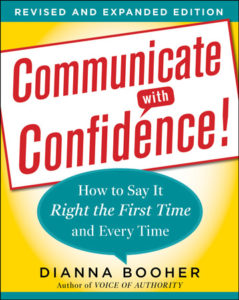


We often hear the phrase “tone deaf” in political circles. By that, people mean someone is oblivious to what others are feeling, thinking, and even saying. The tone-deaf person doesn’t pick up on the subtleties of the situation and how their message sounds to others—either harsh, overbearing, insensitive, or otherwise inappropriate.
But tone-deafness goes far beyond politicians; the condition also afflicts leaders in the workplace.
As any professional keynoter knows about speaking success: Rule #1: Before you take the stage, assess the audience. Before the actual speech, research trends in their industry. Know the typical background of your audience members—educational level, interests, goals. Ask and understand their everyday challenges, tasks, and needs.
The same is true for any communication: Focus on the environment, culture, habits, happenings, interests, and expectations of the other person before you shape and share your message.
You never market, write, or speak in a vacuum.
If in doubt about how some communication will “come across” to another person, imagine how you would feel or what you would think if someone said the same thing to you. Slighted? Minimized? Dismissed? Overwhelmed? Hopeless? Angry?
If in the same situation, you’d take the comment as a neutral statement, you’re on the right track. If you’d wonder what they meant by such a comment, then reconsider, rephrase, or replace the remark altogether.
On occasion, your attitude behind your words may be completely neutral or even positive. But it simply strikes someone the wrong way. Often, that misunderstanding can be attributed to a single word or phrase—a “hot” word like unfair, complaint, overdue, incomplete, unaware, questionable.
Or instead of a “hot word,” maybe you’ve used an overly formal and unfamiliar word that makes your comment sound stuffy, blunt, or cold. Examples of stuffy, formal phrasing: “proceed” rather than “move ahead.” “Utilize” rather than “use.” “Commence” rather than “begin.”
To become aware of such wording in your communication, actually SAY the words aloud to yourself. Read aloud what you’ve written. (If you don’t want to feel silly in doing this, use your phone and pretend you’re in a conversation.) Your own ears will help you identify stuffy, formal, cold words that convey a distant, even antagonistic, tone.
When you don’t have time or opportunity to research your listener(s)—such as handling a crisis or giving instructions to a large group—at least pay attention to their body language as you speak.
Do they look exhausted and “zoned out”? Consider the difference in your own receptive attitude when hearing information at 11:00 am versus 11:00 pm. As the cliché goes, “Things will look better in the morning.”
Do your listeners look fearful? Consider how you can be reassuring.
Do they look angry? Can you communicate empathy and understanding of their perspective or situation?
Do they look disappointed? Can you rephrase or offer details to make them more hopeful?
A listener’s body language is far more accurate than their words. Be attentive to facial expressions, posture, movement—or the lack thereof.
Your words may be neutral while your body language says something quite different. Is your head cocked to the side, with your chin raised? That conveys arrogance.
Are your words reassuring while your hands fidget and your feet shuffle. That conveys lack of confidence in the reassurances that you’re delivering.
Are you avoiding eye contact? That may convey dismissiveness, disrespect, anger, or unconcern.
Your body language is the packaging around your words—the primary “message” that others receive.
Leave tone-deafness to the politicians and the predatory. If you intend to “connect” with colleagues and clients, aim for self-awareness in your communication.
Learn more about how tone affects your words in Communicate With Confidence!: How to Say It Right the First Time and Every Time.
